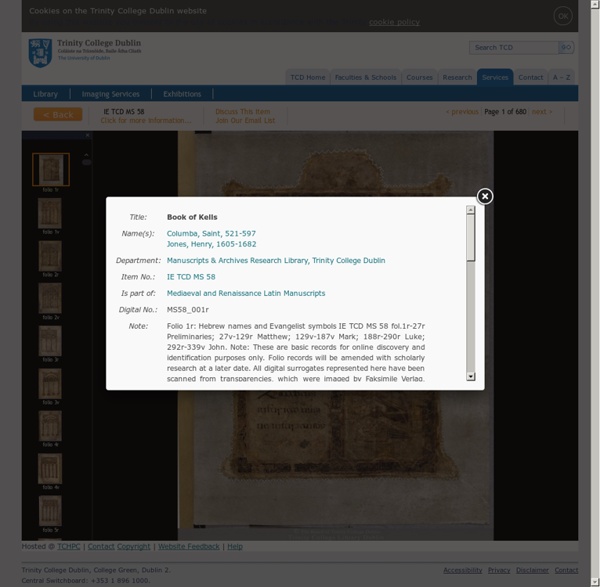DRIS Trinity College Library Dublin
Title: Book of Kells Name(s): Department: Item No Is part of: Digital No MS58_001r Note: Folio 1r: Hebrew names and Evangelist symbols IE TCD MS 58 fol.1r-27r Preliminaries; 27v-129r Matthew; 129v-187v Mark; 188r-290r Luke; 292r-339v John. Abstract: The Book of Kells contains the four Gospels in Latin based on the Vulgate text which St Jerome completed in 384AD, intermixed with readings from the earlier Old Latin translation. Type of work: Dimensions: 33 x 25 cm Materials: Subjects: Publisher: Copyright: Copyright 2012 The Board of Trinity College Dublin.
Meeting about tour and dinner on our own
The Do's and Don'ts of Dining Etiquette Around the World [Infographic]
If you’re any sort of mister manners when it comes to dining etiquette, you know the basics of American restaurant behavior. Splitting the check – usually OK. Letting out an impressive burp at a fine dining establishment – not so much. These unspoken rules are pretty clear-cut. This helpful infographic navigates curious eaters through etiquette around the world. Picthx The Restaurant Choice, Visual.ly Cameron Simcik Cameron is a Philadelphia native who is borderline obsessed with chocolate, coffee and sushi.
Dublin's Georgian Garden Squares
The “Getting Shit Done” Sleep Cycle | PRSUIT
As an entrepreneur my work schedule tends to be much different than a standard 9-5 job. I’d like to think that my lifestyle is unique, but I know there are thousands of other entrepreneurs out there sharing in my late night hustle.I read an article today about a 22 year old who has spent the last two years living on 4.5 hours of sleep per night. Interestingly enough this works out to earning him an extra two months worth of awake time every year. As I read the article I couldn’t help but to laugh. Not only did I have this guy beat by an additional three years of practicing my own unusual sleep cycle, but I had no clue that there are several different types of sleep cycles in the first place. Most people follow a monophasic sleep schedule, which involves seven to eight hours of continuous sleep every night. A typical workday for me starts at around 9am. This type of sleep may be known as biphasic sleep, but I refer to it as the “getting shit done” sleep cycle 6pm-7pm- Dinner.
The Old Library & the Book of Kells Exhibition
Trinity College Dublin has been voted the No. 2 top attraction in Ireland to visit on TripAdvisor's list of Ireland's Top 10 Attractions for 2013, and has also been awarded a TripAdvisor's Travellers' Choice Award. Due to security arrangements for the Trinity Ball - the Old Library and the Book of Kells Exhibition will close on Friday 4 April 2014 at 13:00 rather than 17:00 and will remain closed for the rest of the day. Welcome! Welcome to the Old Library and the Book of Kells Exhibition - a “must see” on the itinerary of all visitors to Dublin. Visitors enter through the Library Shop and proceed to the Book of Kells "Turning Darkness into Light" exhibition; then to the Treasury where the Book of Kells and other related manuscripts are on view; then proceed upstairs to the magnificent Long Room which houses 200,000 of the Library’s oldest books in its oak bookcases. Exhibitions are held in the Long Room to display the rich holdings of the Library and encourage further research.
A Day at the First Video Game Rehab Clinic in the US
I'm somewhere in the hushed hinterlands beyond Bellevue and Redmond, Washington, the hometowns of Nintendo of America, Microsoft Game Studios, Valve, Sony Online Entertainment (Sony’s MMO studio), Bungie, Sucker Punch, and perhaps dozens of other game developers whose creative works enthrall millions. This part of Fall City is so rural there aren’t even houses lining the streets, only a silent density of evergreens that occasionally yawned open to reveal gravel roads with Dead End signs posted at their entrances. Such was the road leading down to Heavensfield, the name of the five acre, ranch-like estate home to reSTART, the first in-patient treatment facility devoted exclusively to video game and internet addiction. I don’t have a car, so my friend Corey, with his piercing-eyed toddler strapped into the backseat, drove me the 30 or so miles east from Seattle to reSTART's center. It's here that we're greeted by Dr. Curiously, there are only men here. But it's not just gaming.
The Great Wide Somewhere
Lacing Shoes
Are all of your shoes, sneakers and boots still laced up the way they were when you bought them? This section presents some of the many fascinating ways of lacing, either for different functions or just for appearances. Why not take the plunge? Whip out those laces and re-do them to suit your needs or personality. Table of Contents Shoe Lacing Methods This section presents a fairly extensive selection of 50 shoe lacing tutorials. Bi-Color Lacing Methods Lacing shoes with two different colors is a great way to display country or team colors or simply to make use of the spare shoelaces that are supplied with many sneakers nowadays. Lug Lacing Methods Many shoes, sneakers and boots come with lugs instead of eyelets. Create-a-Lace Experimenting with shoe lacing methods on a real shoe can be tedious. 2 Trillion Lacing Methods? On an average shoe with six pairs of eyelets, there are almost 2 Trillion ways to feed a shoelace through those twelve eyelets! Shoe Lacing Comparison Shoe Lacing Ratings
Related:
Related:



